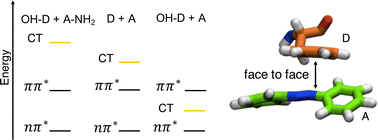Effect of stacking interactions on charge transfer states in photoswitches interacting with ion channels†
Abstract
The activity of ion channels can be reversibly photo-controlled via the binding of molecular photoswitches, often based on an azobenzene scaffold. Those azobenzene derivatives interact with aromatic residues of the protein via stacking interactions. In the present work, the effect of face-to-face and t-shaped stacking interactions on the excited state electronic structure of azobenzene and p-diaminoazobenzene integrated into the NaV1.4 channel is computationally investigated. The formation of a charge transfer state, caused by electron transfer from the protein to the photoswitches, is observed. This state is strongly red shifted when the interaction takes place in a face-to-face orientation and electron donating groups are present on the aromatic ring of the amino acids. The low-energy charge transfer state can interfere with the photoisomerization process after excitation to the bright state by leading to the formation of radical species.



 Please wait while we load your content...
Please wait while we load your content...